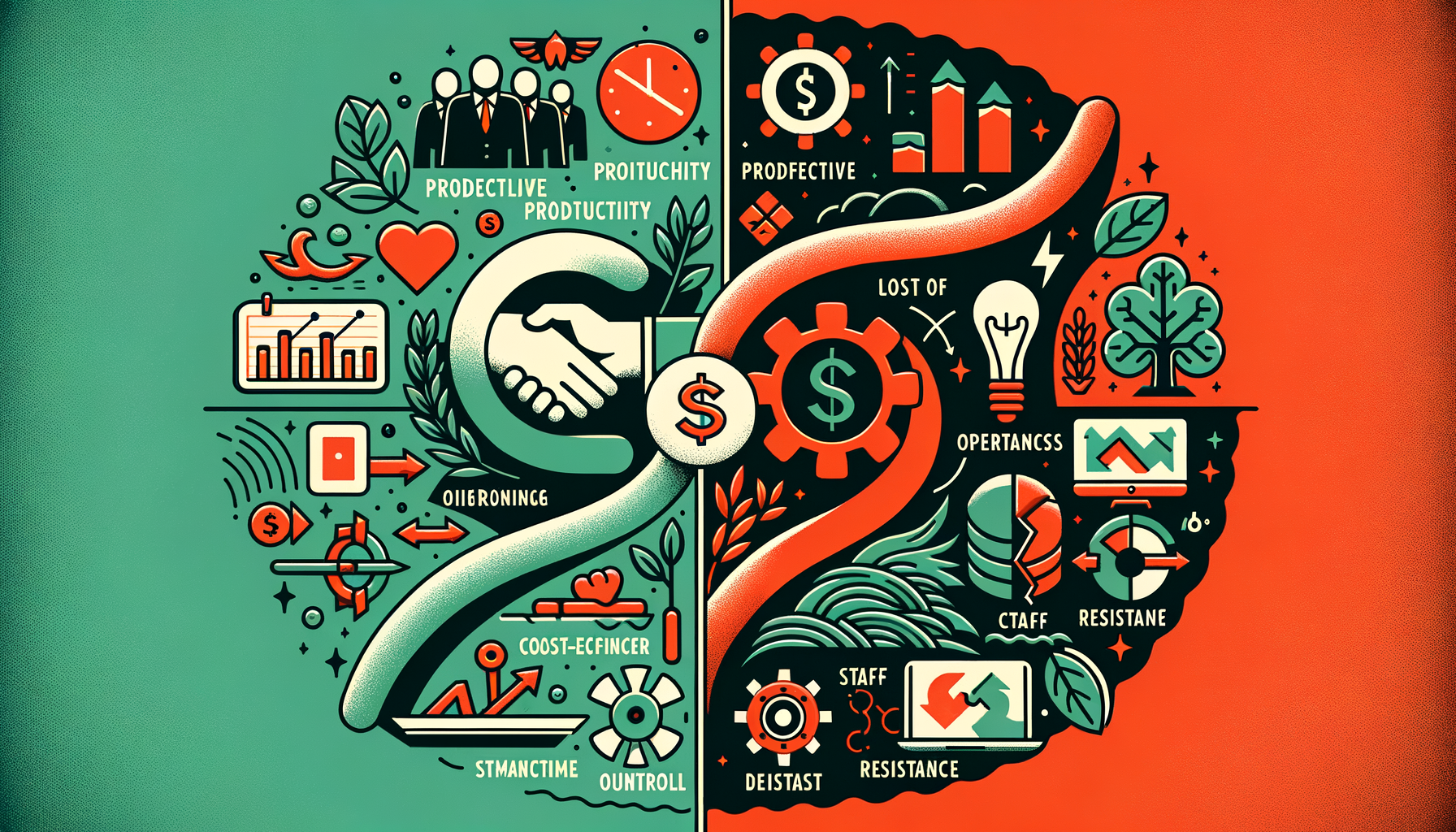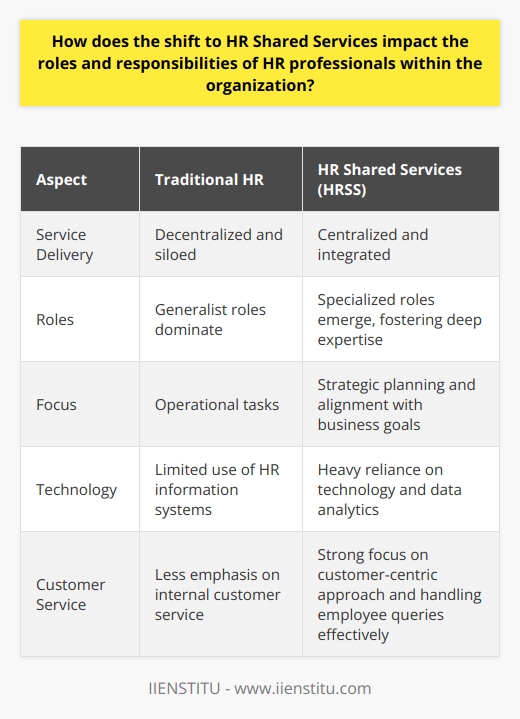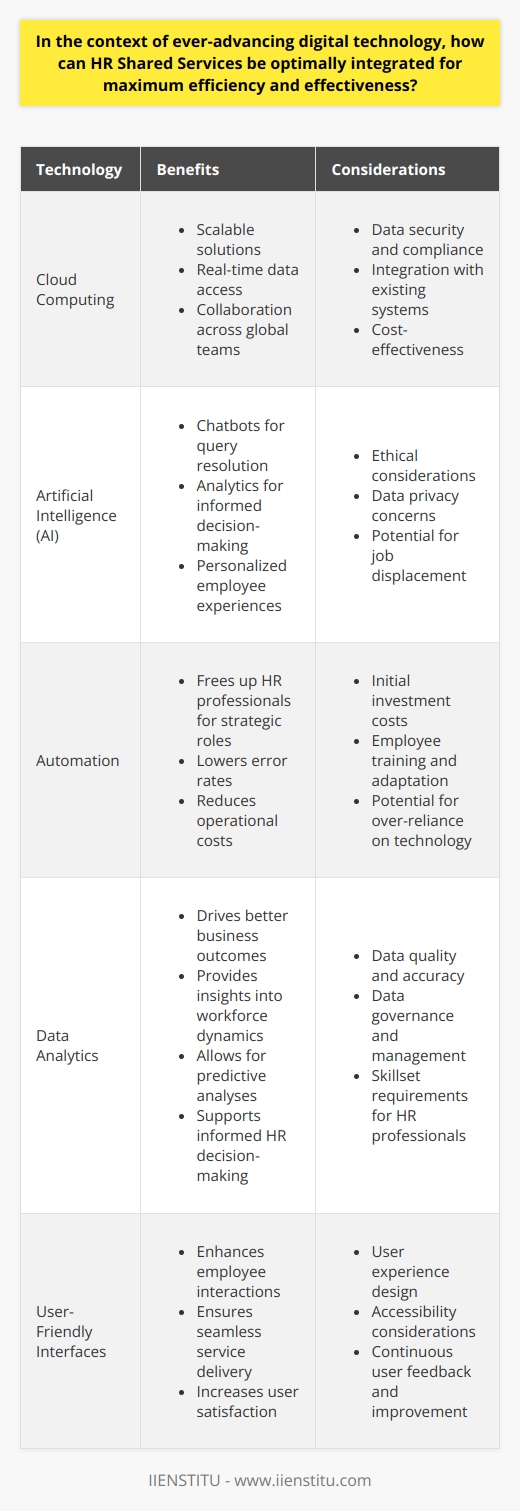
I remember our CEO calling an all-hands meeting to discuss transforming our HR department. The buzzword of the day was "HR Shared Services," a concept that, at the time, felt both exciting and daunting. As someone who had spent years in traditional HR roles, overhauling our processes was intimidating. But looking back now, embracing HR Shared Services was one of the most impactful decisions we made—not just for our department but the entire organization.
Human Resources has always been the heart of any organization, but its role has evolved dramatically over the years. No longer just the gatekeepers of hiring and firing, HR departments are now strategic partners that drive organizational growth. One of the critical catalysts for this transformation is adopting HR Shared Services. This model has revolutionized how HR functions, bringing efficiency, consistency, and strategic focus to the forefront.
Discovering the Power of HR Shared Services
My first real encounter with HR Shared Services was at an industry conference a few years ago. A speaker from a leading multinational company shared how they transformed their HR operations through this model. As I listened, I couldn't help but think about the challenges we faced back home—disjointed processes, inconsistent employee experiences, and an overburdened HR team swamped with administrative tasks. The idea of overhauling our processes was intimidating, and there were certainly fears and doubts about the potential success of such a transformation.
What Exactly Are HR Shared Services?
In simple terms, HR Shared Services involve centralizing everyday HR tasks into a single unit that serves the entire organization. This could range from handling payroll and benefits administration to managing recruitment processes and employee data. The goal is to provide consistent, efficient services while freeing HR professionals to focus on strategic initiatives. It's important to note that this transformation is not just about the model, but about the people who make it work-the HR professionals who are empowered to drive strategic initiatives and make a real difference in the organization.
I found a great explanation in "Human Resource Transformation: Demonstrating Strategic Leadership in the Face of Future Trends" by William J. Rothwell. Rothwell describes HR Shared Services as a way to "streamline operations and create value by eliminating redundancy." This definition resonated with me and helped clarify the potential benefits for our organization.
The Strategic Impact on Our Organization
Implementing HR Shared Services wasn't just about efficiency; it was a strategic move that aligned our HR goals with the company's broader objectives, empowering us to drive organizational growth.
Shifting from Administrative to Strategic
Before the shift, our HR team was bogged down with day-to-day tasks. I recall spending countless hours processing paperwork, which left little time for initiatives like talent development or succession planning. With the new model, we centralized these routine tasks, inspiring our team to focus on projects that directly impacted our company's growth.
Aligning with Business Goals
By freeing up resources, we could finally tackle strategic projects. For instance, we launched a leadership development program to nurture internal talent, which paid off when we promoted several employees to managerial positions. Seeing team members grow into leaders was incredibly fulfilling and reinforced the value of our new approach.
The Journey of Implementation
Transitioning to an HR Shared Services model was challenging. The process required careful planning, stakeholder buy-in, and a willingness to embrace change.
Overcoming Resistance
Change is always challenging, and we face skepticism from various departments. Managers were concerned about losing control over their HR functions. To address this, we held informational sessions to explain the benefits and provide a platform for concerns. Transparency was key. We eased fears and built support by involving stakeholders in the planning process.
Navigating the Change Management Process
We leaned heavily on Kotter's 8-Step Change Model, which I had read about in John P. Kotter's "Leading Change." This framework guided us through establishing a sense of urgency, forming a powerful coalition, and generating short-term wins to build momentum. Celebrating small victories, like reducing payroll processing time by 50%, kept the team motivated.
Training and Development
One unexpected challenge was the need for new skill sets. Our HR staff needed training on the new systems and processes. We invested in professional development, which eased the transition and boosted morale. It was rewarding to see colleagues gain confidence with the latest technology.
Reaping the Benefits
The positive impacts of implementing HR Shared Services became evident quickly, filling us with optimism and excitement about the potential improvements in our own organizations.
Efficiency and Cost Reduction
Streamlining processes led to significant cost savings. We reduced overhead by eliminating duplicate tasks and leveraging technology for automation. According to a study by the Society for Human Resource Management (SHRM), companies can reduce HR operational costs by up to 30% through shared services—an accurate statistic.
Standardization and Consistency
With centralized processes, we achieved a level of consistency that wasn't possible before. Policies were uniformly applied, reducing confusion and enhancing compliance. Employees appreciated the clear guidelines, which improved overall satisfaction.
Enhanced Employee Experience
The most gratifying outcome was the improved employee experience. I remember an email from an employee who was thrilled about the quick resolution of a benefits query—a process that used to take weeks now took just a few days. Providing better service strengthened trust between employees and the HR department.
Focusing on Strategic Initiatives
With administrative tasks under control, we could focus on value-added initiatives. We conducted workforce analytics to identify trends, which informed our recruitment strategies. This data-driven approach was new to us but yielded impressive results, such as reducing turnover in critical departments.
Lessons Learned and Best Practices
Our journey taught us valuable lessons that could benefit others considering this path.
Customize the Model to Fit Your Organization
There's no one-size-fits-all solution. We tailored the HR Shared Services model to align with our company's culture and needs. Engaging with teams across the organization helped us design a system that worked for everyone.
Leverage Technology Wisely
Investing in the right technology was crucial. We selected an HR Information System (HRIS) that integrated seamlessly with our existing tools, minimizing disruptions and enhancing user adoption. In "The Digital Transformation Playbook" by David L. Rogers, the author emphasizes the importance of technology in enabling organizational change—a point that certainly holds for us.
Keep Employee Experience at the Forefront
Throughout the process, we prioritized the impact on employees. Regular surveys and feedback sessions allowed us to make adjustments as needed, improving the system and making employees feel heard and valued.
Looking to the Future: The Evolving Landscape of HR Shared Services
The journey continues after implementation. The world of HR is continually evolving, and staying ahead means anticipating future trends.
Embracing Digital Transformation
Digital technologies like artificial intelligence (AI) and machine learning are set to revolutionize HR Shared Services. We're exploring AI-powered chatbots to handle routine inquiries and provide instant support to employees. A recent article in Harvard Business Review highlighted how AI can enhance HR functions by offering personalized employee experiences—a development we're eager to adopt.
The Rise of Predictive Analytics
Predictive analytics is another exciting area. By analyzing data trends, we can forecast staffing needs and identify potential challenges before they arise. This proactive approach aligns with our goal of being strategic partners in the business.
Focusing on Employee Well-being
The future of HR isn't just about technology; it's also about people. We're emphasizing employee well-being more, recognizing that a happy workforce is more productive and engaged. Initiatives like flexible work arrangements and mental health support are becoming integral parts of our HR strategy.
Conclusion
Reflecting on our journey, I feel proud of what we've accomplished. Transitioning to an HR Shared Services model was challenging, but the rewards have been substantial. We've improved efficiency and reduced costs, enhanced the employee experience, and positioned HR as a strategic partner in the organization.
If there's one advice I'd offer to others considering this path, it's to keep people at the center of the transformation. Technology and processes are essential, but the human element truly drives success.
References:
Rothwell, W. J. (2015). Human Resource Transformation: Demonstrating Strategic Leadership in the Face of Future Trends. HR Press.
Kotter, J. P. (1996). Leading Change. Harvard Business School Press.
Rogers, D. L. (2016). The Digital Transformation Playbook: Rethink Your Business for the Digital Age. Columbia Business School Publishing.
Society for Human Resource Management (SHRM). (2018). HR Shared Services: Improving Efficiency and Effectiveness. SHRM Research Reports.
Harvard Business Review. (2020). How AI Is Reinventing Human Resources. HBR Articles.
Embarking on this journey has been both challenging and rewarding. The landscape of HR is changing rapidly, and embracing models like HR Shared Services positions us to meet the future head-on. I'm excited to see where this path leads us next and am grateful for the opportunity to grow alongside my organization.
Frequently Asked Questions
What are the key benefits and potential drawbacks of implementing HR Shared Services in a company?
Key Benefits of HR Shared Services
Efficiency and Cost-Saving
HR Shared Services streamline operations by consolidating tasks centrally. This centralization boosts efficiency and reduces costs through economies of scale. The HR function becomes more systematic, and the repetition of basic tasks is minimized. Thus, time and resources are saved.
Enhanced Service Quality
Standardization underpins HR Shared Services. Processes become uniform and consistent, resulting in predictable and reliable service. This predictability assures employees of quality.
Better Use of Technology
Technology is central to HR Shared Services. Systems integrate for improved data management. Employee self-service portals are examples. These technologies automate routine inquiries, freeing HR professionals for higher-value work.
Potential Drawbacks of HR Shared Services
Implementation Challenges
Setting up HR Shared Services is complex and requires significant upfront investment. Aligning technology and restructuring teams takes effort, and internal resistance may surface. Change management is critical for success.
Potential for Reduced Personalization
HR Shared Services often aim for efficiency. This focus can reduce one-on-one interaction, and employees might miss the personal touch. High-volume, low-complexity tasks gain priority, which may affect response to unique employee needs.
Risk of Over-Standardization
Standardized processes have advantages. There is a flip side. They may stifle flexibility. Unique business unit needs can suffer. Applying one-size-fits-all solutions is risky. Tailored HR strategies might be necessary.
Dependency on Tech
HR Shared Services is heavily reliant on technology. System failures cause significant disruptions, tech solutions demand constant updates, and cybersecurity threats rise. These factors increase tech-dependency risks.

How does the shift to HR Shared Services impact the roles and responsibilities of HR professionals within the organization?
The Shift to HR Shared Services: A Game Changer for HR Professionals
Understanding HR Shared Services
The move to HR Shared Services (HRSS) is a strategic approach that seeks efficiency and uniformity in delivering HR support. Many organizations now turn to this model to centralize tasks and services.
Changes in Roles and Responsibilities
With HRSS, HR professionals witness a significant role evolution. They must adapt, re-skill, and anticipate new demands. Traditional, siloed HR tasks give way to a more integrated service delivery.
Specialization Over Generalization
HR staff increasingly specialize in specific HR functions. Generalist roles reduce while expert positions emerge, fostering deep expertise and higher-quality HR support.
Strategic Over Operational
HR professionals shift their focus from operational tasks to strategic planning. They must now think big-picture and contribute to business strategy, which requires a strong grasp of the organization's vision and objectives.
Technology as an Enabler
HRSS relies heavily on technology for service delivery. Therefore, professionals must become adept at using HR information systems and understand data analytics to inform decision-making.
Enhanced Customer Service Skills
The shift to HRSS often brings about an internal customer-centric approach. HR pros must now have strong customer service skills. Competence in handling employee queries quickly and effectively is critical.
Adapting to the HRSS Model
The Learning Curve
Adapting to the HRSS model involves a learning curve. Training and development play crucial roles in this transition. HR professionals must stay abreast of best practices in shared services.
Collaboration and Teamwork
With shared service models, teamwork takes center stage. Cross-functional collaboration is essential for success. HR pros must work in sync with various departments and understand their needs.
The Strategic Partner
HR becomes a strategic partner within the organization. Pros must align HR functions with business goals. They should offer insights that drive organizational success.
Advisory Role
HRSS often requires HR to take on an advisory role. HR guides managers and staff through HR processes and systems and provides specialized advice on people management issues.
The HRSS model redefines roles and responsibilities within HR. Professionals must now diversify skills and focus on value addition. They should become strategic partners, savvy with technology, and adept in specialized domains. The aim is not merely to reduce costs but to enhance HR's strategic contribution. The ultimate goal: leverage HR to drive organizational success.

In the context of ever-advancing digital technology, how can HR Shared Services be optimally integrated for maximum efficiency and effectiveness?
The Digital Evolution in HR Shared Services
The digital age has transformed HR Shared Services (HRSS). Advanced technologies now streamline operations, and efficiency and effectiveness have become pivotal metrics. HRSS integration calls for strategic planning and careful consideration of current technologies.
Understanding HRSS Integration
HRSS integration requires clear objectives that must align with organizational strategies. Integration aims to enhance productivity, improve employee experiences, and reduce redundancies.
Leveraging Technology for Integration
Cloud computing has become the backbone of HRSS. It allows for scalable solutions. Cloud platforms facilitate real-time data access. They also enable collaboration across global teams.
Artificial intelligence (AI) reshapes HR functions. It powers chatbots for query resolution, provides analytics for informed decision-making, and personalizes employee experiences.
Automation of repetitive tasks frees up HR professionals, allowing them to focus on strategic roles. It also lowers error rates and reduces operational costs.
Data analytics drive better business outcomes, provide insights into workforce dynamics, allow for predictive analyses, and support informed HR decision-making.
Strategies for Optimal HRSS Integration
- Define clear integration goals
- Select technologies that align with business needs
- Ensure robust data security and compliance
- Focus on user-friendly interfaces
- Train HR staff on new systems
- Monitor and refine integration processes constantly
Employee engagement must be a top priority. Technologies that enhance employee interactions are crucial. Seamless service delivery depends on user satisfaction.
Performance metrics must reflect integration success. They must track efficiency and effectiveness gains. Continual feedback loops are essential.
Best Practices for HRSS Integration Success
Securing Organizational Buy-In
Leadership must support HRSS integration, and employees must understand the benefits. Communication strategies are key; they ensure a clear understanding of new processes.
Fostering A Culture of Continuous Improvement
Organizations must embrace change. They should foster innovation. Continuous improvement should be part of the company culture.
Learning opportunities must be ongoing. They ensure teams stay adept at using new technologies. Training allows for rapid adaptation.
Assessing and Mitigating Risks
Risk assessment is integral to HRSS integration. Potential challenges must be identified early, and mitigation strategies must be in place.
Compliance with regulations must remain a constant. Data privacy concerns must be addressed. Security protocols must evolve with technological advances.
Integration of HR Shared Services in the digital era presents opportunities. It demands careful consideration of technologies and their applications, strategic planning, and paramount attention to employee experiences.
Success hinges on organizational alignment and continuous evaluation. Security and compliance must never be neglected. Through judicious integration, HRSS can reach peak efficiency and effectiveness and contribute significantly to achieving broader business goals.



